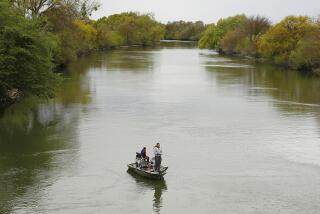Hurricane Gustav batters Louisiana’s southern coast
NEW ORLEANS -- Hurricane Gustav rammed ashore against the depopulated southern coast of Louisiana this morning, weakened but still dangerous as it aimed west of New Orleans with high winds and volatile storm surges.
Gustav roared into the mainland near the small town of Cocodrie just after 10 a.m. CDT, the National Hurricane Center in Miami reported. The storm had reduced in strength overnight to a Category 2 storm, driving sustained winds of 110 miles an hour that bent trees, spawned funnel clouds and filled the air with slanting rain and flying debris.
The hurricane’s diminished assault and its westward arc away from New Orleans raised hopes among public officials that after Sunday’s unprecedented evacuation of 2 million people, the region might be spared the devastation unleashed three years ago by Hurricane Katrina.
But many hurricane veterans remained cautious about the possibility of storm surges that could overwhelm the city’s levees, still wary from Katrina’s flooding in 2005 and now worried by the oncoming destructive flank behind Gustav’s eye.
“We’re not out of the woods yet, that’s the main message,” New Orleans Mayor C. Ray Nagin said in an interview with WWL-TV. “We still have critical hours between today and tonight.”
Initial reports indicated that the city’s internal levees, all breached during Katrina, were holding, Nagin said. But there were reports just before noon of flooding into the Lower 9th Ward, the poor enclave submerged by Katrina in 2005.
And a strong storm surge inside the large Industrial Canal, the 5.5 mile waterway that connects Lake Pontchartrain to the Mississippi River, also showed early evidence of overtopping along some levee walls, a worrisome sign to Nagin and U.S. Army Corps of Engineers officials.
“That’s the biggest problem we have at the moment,” Nagin said. He also said he was alarmed by reports that several barges had broken free from moorings inside the canal, becoming possible projectiles that could pierce fragile levee walls.
Army Corps officials confirmed that two large barges that had been tied up were now loose in the Industrial Canal. During Katrina, a loose barge broke out of the Industrial Canal and crushed several houses in the 9th Ward.
Suzanne Fournier, an Army Corps spokeswoman, said officials could not do anything about the barges until the hurricane passed over the region. One of the barges -- a vessel 75 by 500 feet long -- was partially sunk. “I don’t think that’s good,” Fournier said.
At 4:30 a.m., the Army Corps closed a major floodgate meant to cut off the Harvey Canal from the waterways below it -- a post-Katrina improvement aimed at protecting the city’s West bank.
Gusting winds took a toll on the region’s power grid, downing dozens of electric lines and leaving more than 25,000 Entergy New Orleans customers in the dark.
Rain lashed sideways across the still-rebuilding Lakeview community near the city’s 17th Street Canal, devastated by Katrina three years ago -- but diehards who remained said the levee walls there were holding so far.
“So far so good, I haven’t seen any accumulation coming from the levee,” said Mark Harbison, a petroleum engineer who had hunkered down overnight in his home, just 200 yards from the 17th Street Canal walls.
Tree branches and political campaign signs tumbled in the 60 mph gusts as Harbison made forays outside into the blowing wind to clear debris from the street drains around his house. He returned drenched in his raincoat and boots, but still optimistic.
“This is nothing compared to Katrina,” he said, “even the winds.”
But Gustav’s spiraling gusts spurred whirling funnel clouds and isolated reports of tornadoes near the suburban communities of Slidell and Picayune. And on Mississippi’s Gulf Coast, heavy winds and widespread flooding overwhelmed low-lying areas.
In Gulfport, storm surge water rushed over Highway 90, forcing authorities to close the major thoroughfare all the way across the county. Waves pounded Biloxi Beach, and at St. Charles Avenue and Beach Boulevard, water rose as high as a fire hydrant, and tree limbs lay scattered in the street.
High winds also kept 2,040 Louisiana National Guard troops bottled up inside the city’s Convention Center, sleeping on cots or nibbling on ample supplies of prepared meals. By mid-morning, there had been no requests for assistance, said Guard Sgt. Major William Migues. Approximately 12,000 power outages were reported across Mississippi, with the majority happening in the coastal counties of Hancock and Harrison.
Fausset and Zucchino reported from New Orleans, Braun from Washington, and Ann M. Simmons from Gulfport, Miss.
More to Read
Sign up for The Wild
We’ll help you find the best places to hike, bike and run, as well as the perfect silent spots for meditation and yoga.
You may occasionally receive promotional content from the Los Angeles Times.







